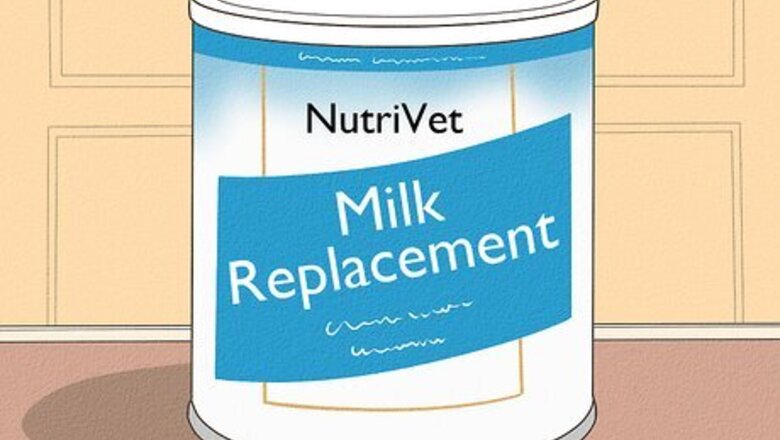
views
Gathering the Right Equipment

Purchase kitten milk replacement formula. Newborn kittens have a delicate stomach and won’t be able to digest average milk. Therefore, you will need to purchase kitten milk replacement (KMR) formulas to feed the baby kitten. Some of the best kitten milk replacement formulas are Nutri Vet, Hartz, Just Born, Nurturall-C and Pet Lac. These have all the necessary nutrients needed by kittens to thrive. They can be found at a good pet supply store. You should never give a kitten cow's milk, goat's milk, any kind of plant-based milk, or even "cat milk" as it can cause diarrhea and dehydration in young kittens. Only ever give a kitten designated kitten formula!

Avoid giving the kitten homemade formula. Some people try to make their own formula, but it is best if you stick to the store-bought ones recommended above. Newborn kittens have a delicate digestive system and you risk upsetting it if you make even a slight mistake in mixing the formula. In an emergency situation when you don't have access to kitten formula, you can feed the kitten a few drops of warm treated milk to prevent dehydration. To treat the milk, brink it to a boil and then cool it back down to slightly warm.
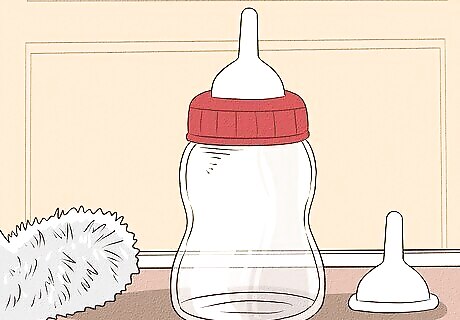
Buy a kitten feeding bottle. Thankfully, there are specially-designed kitten feeding bottles available to buy in pet supply stores. These bottles have a nipple without any holes, so that you can make a small hole according to the individual kitten’s requirement. You can make a hole by heating a needle and simply puncturing the nipple from the tip. Another way to create a hole in the nipple is to cut it on an angle with sharp scissors or to cut a small "X" into the tip. Since you do not want the kitten to choke, you should only make a small hole which allows one drop to escape at a time, or two at the most. You can make sure that the hole is the correct size by filling the bottle with formula and inverting it over your hand or forearm. The formula should slowly drip out one drop at a time.

Consider getting a small syringe for very small kittens. If you think feeding the kitten with a bottle might be too difficult for you, you can buy a small syringe designed for feeding kittens. This works well for the first few weeks, when very small kittens won’t be able to take more than a few cc at a time and don't understand drinking from a bottle. Make sure to use a new syringe every couple of feedings, because used syringes can become dangerous for small kittens if they are not moving smoothly. Alternatively, a small dropper used to administer medicine to babies can also be used to feed a newborn kitten. You can get these from any pharmacy or a grocery store. Just make sure that you get more than one so that you have extras in case one doesn't work properly.
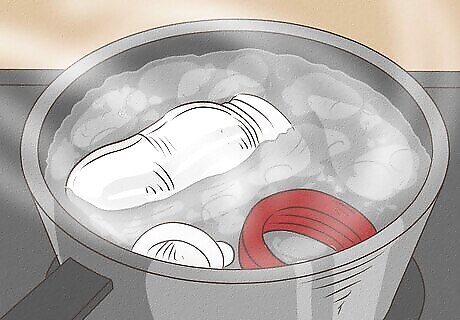
Sterilize the feeding equipment. Once you have purchased the feeding bottle, syringe,` or dropper, the next step is to sterilize it all. You can simply fill half a pan with water and bring it to boil. Turn off the stove, put everything in the pan and cover it with a lid. This helps to clean the instruments thoroughly, making them completely free of germs. You need to sterilize even the new equipment because it might have germs from being handled by people in the store. If you want to be extremely careful, you’ll have to sterilize the equipment before every feed. Otherwise, you can just wash it properly after every feeding session and sterilize it once every day.
Feeding the Kitten Properly

Mix the kitten replacement formula. Every kitten replacement formula comes with instructions on how much formula you need to mix in how many cubic centimeters or millimeters of water to get the best results. Make sure that you follow these directions exactly, to ensure that the kitten gets the correct amount of nutrition. The milk should be warmed to about 95 °F (35 °C), or body temperature. You can test the warmth by inverting the bottle over your arm. If it is comfortably warm for your skin, it should be the right temperature for the kitten. You should always mix the formula just before feeding time. If it has been sitting for more than 3 hours, don’t use it.
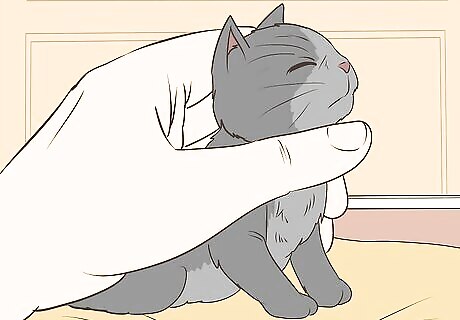
Hold the kitten correctly while feeding. When you feed the kitten, hold it horizontally with the belly facing downwards and the head tilted slightly upwards. You should never feed a kitten on its back, because this can cause them to aspirate, or inhale fluid into their lungs. Think of how a kitten would eat from its mother.

Feed the kitten a few drops of milk at a time. Try feeding the kitten using a syringe or a dropper. If you are using a feeding bottle, insert the nipple into the kitten’s mouth and hold their head to direct their mouth to suckle. Always have a finger on their throat to make sure they are swallowing. Make sure that the flow from the bottle slow and steady, as too strong a flow will cause the milk to come out from the kitten's nostrils. In case this happens, stop feeding immediately and give the kitten a break for a few minutes. Once you resume feeding, try to regulate the flow more carefully.
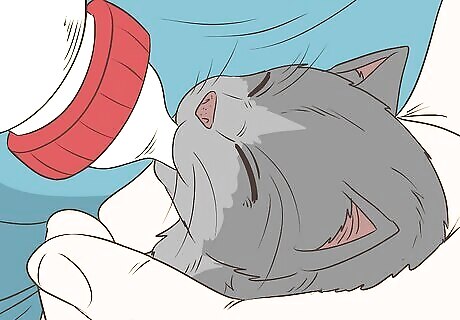
Be careful not to overfeed the kitten. Most people do not know how much formula should be given to a newborn kitten and often end up overfeeding the kitten. Check the directions on your kitten formula to determine how much to feed your kitten. As a general rule, a newborn kitten will nurse for 5 to 10 minutes at a time, never more than that. During the first week, feed the kitten 32 cc of formula per day, broken up into small amounts bottle fed every two hours. There should never be a gap of more than 4 hours between feedings. Keep increasing the formula gradually so that you reach 80 cc per day by week three and 100 cc per day by week four.
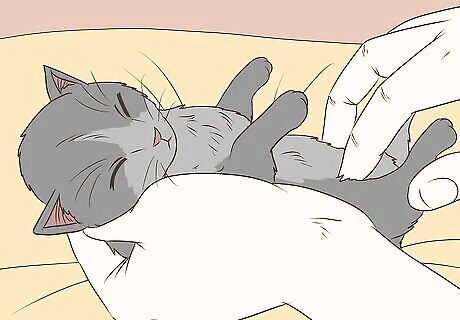
Burp the kitten after feeding. Once you have fed the kitten, you need to help it eliminate gas by burping. Hold the kitten with its belly facing upwards and gently rub his stomach. Continue to do this for 5 to 10 minutes until the kitten burps and then let it go. You’ll have to repeat this procedure after every feed until the kitten is old enough to play around and get plenty of exercise after feeding, which helps in eliminating gas.

Stimulate the kitten to poop and pee. Kittens do not use the bathroom on their own. Instead, their mothers stimulate their rear to make them use the bathroom. You can mimic this by wiping the kitten's rear with a piece of damp cotton wool. Continue to wipe until the kitten has relieved itself. You can stop helping the kitten poop and pee after it starts to do so on its own, which should occur at around 3 weeks of age.
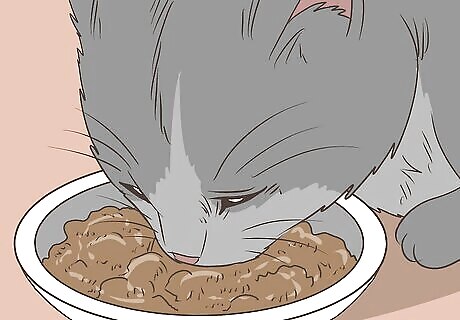
Gradually wean the kitten after four and a half weeks. Once the kitten is four and a half weeks old, you can start weaning by gradually introducing moist food. You can do this by beginning to mix small amounts of wet cat food into their formula and feeding the "slurry" in a bottle to help them get a taste for meat. Then, you can slowly transition their feedings from slurry in a bottle to slurry in a bowl. Between 7 to 8 weeks, kittens are able to eat moistened cat food.
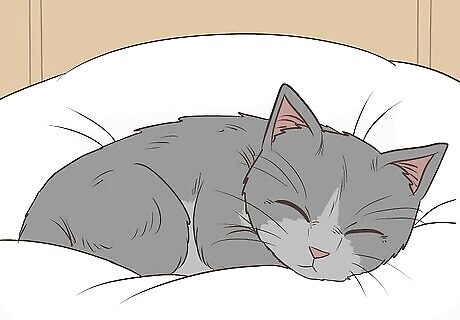
Keep the kitten warm and comfortable. Kittens tend to get chilly very easily, especially if they have been outdoors for long periods of time. To check if the baby kitten is too cold, touch the paws and see if they are cold from underneath. The kitten must be warm so that it can digest food. If the kitten is cold, it will either reject feeding or will not be able to digest it. Even if it eats, the kitten will not be able to take in the nutrients if it is cold. Arrange a box with clean blankets and ensure that all of it is completely dry. You might have to change the sheets often to keep it clean. If the kitten is kept in a clean and warm environment, it will eat more and stay healthy.
Considering What's Best For the Kitten
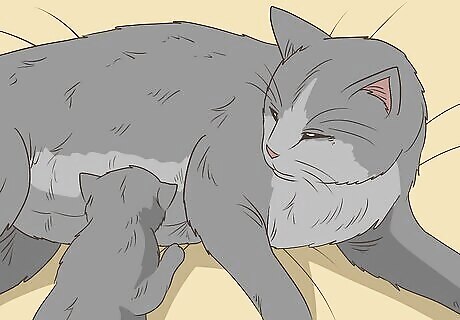
Leave the kitten with its mother if possible. Even though kitten milk formulas are very nutritious, there is no real replacement for mother’s milk. Therefore, a kitten’s best chance of survival is if it stays with the mother until it is at least 8 weeks old. Before you adopt a kitten, make sure that it is over 8 weeks old — a kitten shouldn't be separated from its mother any earlier than this if it can be avoided.
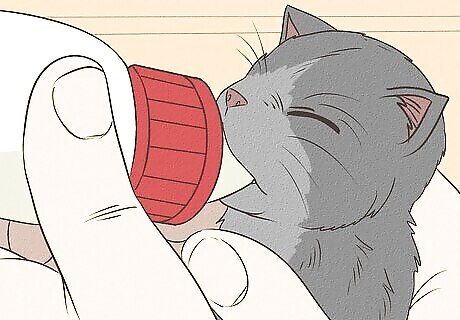
Understand that taking care of a baby kitten is a big commitment. Taking care of a baby kitten can be a huge challenge, even for someone who has done it before. The kitten will need your complete and undivided attention — you will have to be vigilant about monitoring its body temperature, food, and activity levels at all times.
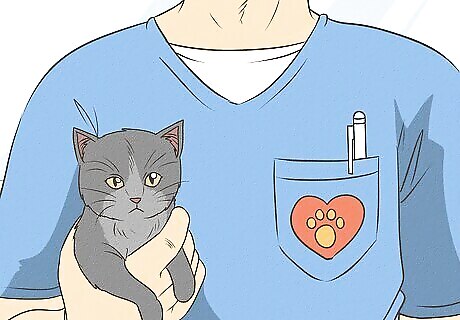
Consider bringing motherless kittens to an animal center. If you have never taken care of a baby kitten before and are now faced with a situation where you have to feed it, you should seriously consider checking with a shelter to see if they can take the kitten and look after it. Most animal shelters have good facilities and experienced staff, so the chances of a baby kitten surviving without its mother are much higher. Some shelters and vet clinics also have foster feline mothers who can feed the kitten as their own until it becomes stronger and healthier.




















Comments
0 comment